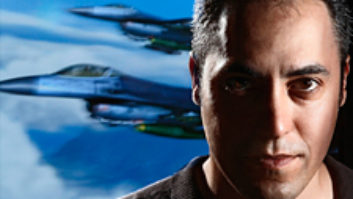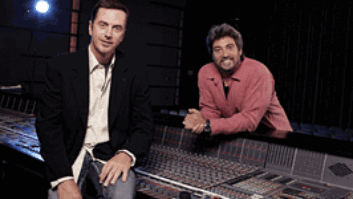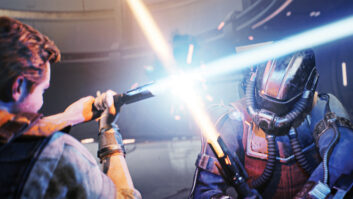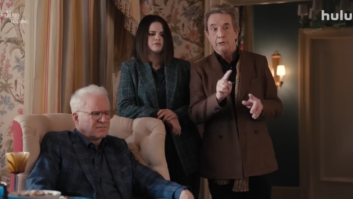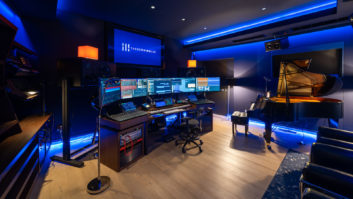For the film score, the producers were fortunate to secure the participation of two-time Oscar winner John Williams, whose many screen credits include original scores for the historical dramas Saving Private Ryan, Schindler’s List and Amistad. In fact, Williams has been nominated three dozen times since his first in 1967 for Valley of the Dolls, and hardly a year goes by without his name appearing on the Oscar ballots.
Orchestral scoring sessions took place in mid-May at the Sony Pictures Studios scoring stage in Culver City. To record and mix, Williams brought in his longtime studio collaborator Shawn Murphy, an independent engineer who has recorded more than 190 film scores over the past two decades. In consultation with the producers and music editor Ken Wannberg, Williams and Murphy decided to record the 7.1 and stereo CD mixes “live,” a working method that requires considerable accuracy and decisiveness in the recording process.
“The vast majority of the recording I’ve done with John has been live mixed,” Murphy notes. “Star Wars was about 95 percent live mixed. It works much better for [Williams] musically, and for me in terms of addressing any musical recording problems right on the spot.”
“For orchestral sessions, it’s fairly common to record the soundtrack CD at the scoring session,” Murphy continues. “We’ll add a little more space to the 2-track mix because a lot of times we keep it fairly dry for the picture, but on this sort of score there’s no reason why the CD can’t come straight off the console.”
Though Murphy and Williams had agreed to deliver a 7.1 mix, a first for both of them, Murphy decided to monitor the sessions in 5.1. “My big problem with SDDS spreads in general is a lack of upward and downward compatibility,” Murphy explains. “The 7.1 spread tends to sound poor when it combines downward to 5.1 and even worse when it goes to Lt-Rt for Dolby Stereo. And it doesn’t make a good stereo for the CD.” Monitoring his mixes in 5.1 provided Murphy with a reliable fallback position. “If there’s any problem in the 7.1 spread, we can immediately go back to 5.1 and we know they work,” he notes.
Despite the fact that almost all audio post-production is now done on digital workstations, Murphy usually records to analog. “John and I vastly prefer it to digital,” he says. “So we try to commit one generation to analog before we send it into an editorial computer if we can-the one generation of analog patina seems to be a nice thing to put on the sound before it goes to the Pro Tools or the Sonic Solutions.”
For his analog 7.1 master, Murphy routed the eight music channels plus pilot tone and timecode to a 15ips Studer 16-track, loaded with Quantegy 456 2-inch tape at a nonelevated alignment (200 nanoWebers/meter) and encoded in Dolby SR. Similarly, the stereo mix for CD went direct to a 11/42-inch format Studer, also 15 ips, Dolby SR. Digital safeties were committed to Genex 8-track MO and DAT formats.
To provide for remixes, two backup 24-track Studers were fed the 7.1 mix and timecode, plus various solo mics and additional section submixes.
“Any remixing that we might do is based on the recording we do on the session,” Murphy explains. “But typically, we choose [a take] based on the live mix and leave it that way.”
FORMERLY MGM
The Sony scoring stage, basically unchanged since its heyday as the MGM soundstage, has been the site of hundreds of historic recordings. “The room is 93 feet wide and 66 feet deep, and about 28 feet at its highest point-it has a slightly peaked ceiling,” says Murphy, pointing at the roofline, dimly discernible above the ceiling trusses and air conditioning ducts. Built in 1929 and with a volume of around 160,000 cubic feet, the Sony stage is considerably smaller than Abbey Road, which is roughly 250,000 cubic feet. “So it’s smaller in volume, but it has a good sound,” Murphy says, noting that the reverb time is relatively short, a little over a second. “Some of the other scoring stages in town are more [reverberant],” he continues. “I think that most people would say that this room is the nicest compromise of volume to reverb time to liveness to control that we have.”
Murphy set up the large orchestra (“in the neighborhood of 95 players”) in a standard configuration, with Williams’ podium in front of the control room window, facing the projection screen. At Williams’ request, the studio provided orchestra risers for the rear row of celli and basses, improving sight lines to the podium and increasing proximity to the room mics. “It gets a bit of air under the instrument and adds some resonance,” Murphy says.
As primary sources for his 5-channel stereo mix, Murphy used the familiar Decca Tree microphone setup with “spreaders.” Three omnidirectional Neumann M50s suspended about 10 feet above the conductor’s position were flanked by a pair of Schoeps 222s with MK21 capsules, each situated about 15 feet wide of center. These primary mics were fed direct to the multitracks, augmented as necessary by a variety of spot and section mics, some of which were used only for reverb sends. Two omni mics located high in the corners of the room provided an overall orchestra ambience, which Murphy routed to the stereo surround channels.
Murphy’s reverb setup included five channels of Lexicon 480 dedicated to the front channels, though returns were also routed to the surrounds at lower levels. As Murphy describes it, the orchestra presence in the surrounds is intended to be supportive. “It’s not meant to call attention to itself-you wouldn’t notice it unless it was shut off,” he notes. As Murphy pointed out, the use of the surrounds in film scoring is restrained in comparison to 5.1 mixing for record, which usually assumes five comparable monitor speakers. “[In film], we use rolled-off surrounds, and we don’t tend to put anything in the surrounds except distance mics or ambient material, unless there’s a specific reason to,” he explains. “Very occasionally there’ll be an effect we want to sweep around into the surrounds-there’ll be an instrument we want to put specifically in back. But that’s not common, that doesn’t happen very often.”
LIVE MIXES AUTOMATED
The Sony scoring stage console is a 72-input Neve VR dating from about 1997. “Prior to that they had a modified 8128, vintage 1984,” Murphy says. “That was only a 56-input console, so the 72-input has helped, though we often bring a Martech sidecar in, which expands this board to 96 inputs. That’s probably the number that a scoring stage needs to have nowadays.” For The Patriot sessions, Murphy used about 54 inputs; Sony also provided a DDA monitor console that stage manager Mark Eshelman used to create headphone mixes for conductor, soloists and section leaders.
Murphy used the Neve’s onboard Flying Faders automation on every take. “I like this automation, and it’s unfortunate that, since Neve and Martinsound have parted ways, this automation doesn’t come with Neve consoles anymore,” he comments. Murphy used the Neve’s preamps for solo and section mics, but routed the seven primary distant mics straight to tape via outboard preamps. The Decca Tree and wide-arrayed Schoeps mics were run through EAR tube preamps, while spot and solo mics were patched into Grace, Boulder and Avalon preamps; all were then multed to the Neve for the live 7.1 and 2-track mixes. Murphy’s use of EQ was minimal: he used five channels of Avalon 2055 EQ on the five front mix buses (approximately +2 at 15 Hz, -1 at 400 Hz, +2 at 25 kHz) and dialed in console EQ on only three channels.
MONITORING
Murphy monitored the LCR mix through his three Wilson Audio WATT VI monitors, an evolution from the WATT I systems he began using in 1987. “In the SDDS matrix, the LE and RE signals are assigned 75/25 to left/center and right/center in the 5.1 crashdown,” he explains. “The monitor panel in the VR desk does not have this capability, so I merely superimposed the LE and RE signals on the left and right monitor channels.” Powered by Krell KSA-250 amplifiers through Transparent Audio Cables, the Wilsons were supplemented by Sunfire subwoofers for the LFE channel (generally referred to as “boom”), which had been aligned to 91 dBC. As Murphy notes, “the 0.1 channel is rarely calibrated, so you never really know how it’s going to sound in the theater.” The stereo surround mix was distributed through JBL bipole speakers mounted high on the side walls of the relatively large control room, but as Murphy had predicted, it was hard to hear if they were on.
Scoring The Patriot took about two weeks, with 13 three-hour sessions scheduled for recording the score and a further two for source music. Throughout the afternoon session that Mix attended, Williams and Murphy repeated much the same process for each cue. After some rehearsal, during which Murphy perfected balances and any necessary fader moves, all four analog tape machines were put into record. As soon as Murphy felt he had a representative performance on tape, Williams and Murphy listened to playback, discussed musical or engineering adjustments, and re-recorded each cue until satisfied.
Working with a conductor who decides on a master “then and there” is unusual, notes Murphy. “It’s unusual in terms of being that definite about what you want and having an orchestration that’s that complete. I’ve always thought that if you can avoid the generation loss, if you can avoid the technical elements of remixing and just do it live, that’s the best.”
Having worked together on scores for about 18 pictures and almost as many album projects, Murphy and Williams are a comfortable and efficient studio team. At the end of the session, as players left the studio and the crowded control room emptied, Williams and Murphy prepared for a playback session to decide or confirm each cue’s master take. Selected 7.1 master takes were then loaded into a Sonic Solutions system, ready for Ken Wannberg to take to the final mix at the Cary Grant Theatre.
